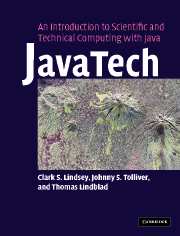Book contents
- Frontmatter
- Contents
- Preface
- Acknowledgements
- Part I Introduction to Java
- 1 Introduction
- 2 Language basics
- 3 Classes and objects in Java
- 4 More about objects in Java
- 5 Organizing Java files and other practicalities
- 6 Java graphics
- 7 Graphical User Interfaces
- 8 Threads
- 9 Java input/output
- 10 Java utilities
- 11 Image handling and processing
- 12 More techniques and tips
- Part II Java and the network
- Part III Out of the sandbox
- Appendix 1 Language elements
- Appendix 2 Operators
- Appendix 3 Java floating-point
- Index
- References
2 - Language basics
Published online by Cambridge University Press: 08 January 2010
- Frontmatter
- Contents
- Preface
- Acknowledgements
- Part I Introduction to Java
- 1 Introduction
- 2 Language basics
- 3 Classes and objects in Java
- 4 More about objects in Java
- 5 Organizing Java files and other practicalities
- 6 Java graphics
- 7 Graphical User Interfaces
- 8 Threads
- 9 Java input/output
- 10 Java utilities
- 11 Image handling and processing
- 12 More techniques and tips
- Part II Java and the network
- Part III Out of the sandbox
- Appendix 1 Language elements
- Appendix 2 Operators
- Appendix 3 Java floating-point
- Index
- References
Summary
Introduction
If you buy one of those do-it-yourself furniture kits, the best way to start is to just dump all of those screws, nuts, planks, tools and other odd looking widgets on the floor, group them into piles of similar looking items, and then go read the instructions. Even if you don't know what all of those widgets are for, it helps to pick them up and look them over so that you become familiar with them and can recognize them in the instructions.
So rather than dribbling them out over several chapters, here we dump out most of the basic widgets needed to construct Java programs. The goal is to start to become familiar with Java's symbols, keywords, operators, expressions, and other building blocks of the language with which to construct programs. We provide examples and starter programs (on the Web Course) that allow you to begin to write programs without needing to understand yet all of these language elements at a deep level. You should refer back to this chapter as you proceed and as your understanding of the language increases.
Note that in this chapter we occasionally mention the terms class, method, and object. If you are new to object-oriented programming, do not worry about these terms for now. We discuss them in detail in the following chapters.
We begin with a listing of the basic elements and then outline the structure of a generic program.
- Type
- Chapter
- Information
- Publisher: Cambridge University PressPrint publication year: 2005

